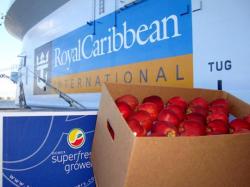Cruise Business Good For Domex Superfresh Growers
January 20, 2010 | 1 min to read

Yakima, WA. Domex Superfresh Growers is cruising into the horizon literally. Weve been working to get our apples and pears onto cruise ships sailing from Miami, says Loren Queen, marketing and communications manager. With increased awareness of their health, even while on vacation, cruisers are looking for healthy snacking options and apples and pears offer them a convenient and familiar way to do that, states Queen.
An average size cruise ship carrying 2,200 passengers and 1,100 crew members will consume nearly as much produce as all meat combined or about 22,000 pounds of fresh fruit and 27,500 pounds of fresh vegetables. That figures out to 15lbs of produce per person during a seven day cruise. That is a significant amount of produce with apples and pears represent about 10% of that total, continues Queen. We primarily send in a smaller piece of fruit than what you see at retail, a 125-count apple. This size of fruit is commonly bagged for domestic sales or exported. Weve worked hard to develop another outlet developed for this fruit, concludes Queen. The varieties sold to the cruise lines are Red Delicious, Golden Delicious, Granny Smith, Gala apples and DAnjou pears.
Source: Domex Superfresh Growers
